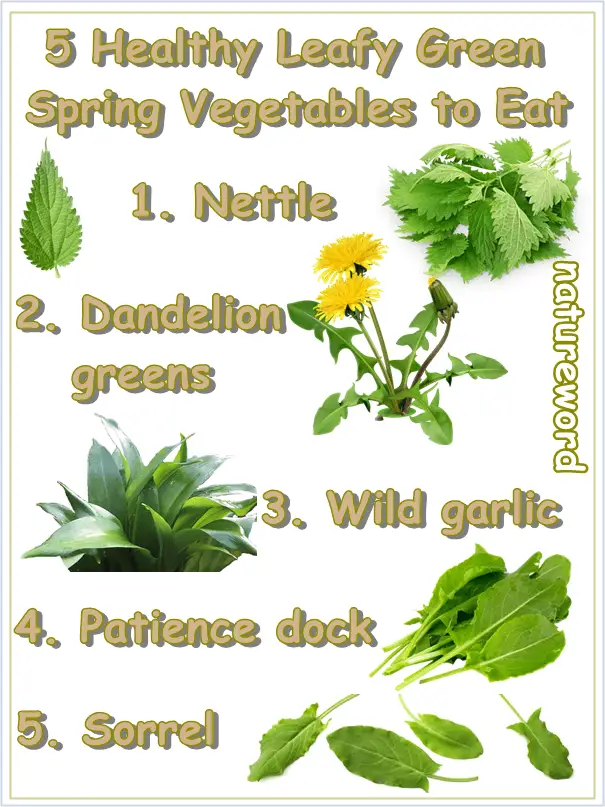Seasonal spring vegetables are the healthiest foods to eat right now. In addition to being in season which makes them readily available, they are often also locally sourced, not to mention full of benefits for health. And if you don’t know where to buy them, or don’t have the option to, you can always forage for plenty of seasonal spring vegetables in the forest if there is one near you, or your own back yard or home garden.
My list of seasonal spring vegetables includes five of the healthiest and most common leafy green vegetables whose season begins at the start of spring. The vegetables in this list are also fairly easy to recognize so you don’t run the risk of confusing them for inedible, or worse, poisonous, greens. You can use these spring vegetables as food in a lot of common and specialty recipes, for dieting purposes, to make tea, get certain nutrients or enjoy specific benefits for your health.

Nettle, common nettle or stinging nettle
Nettle goes by the scientific name Urtica dioica and it’s one of the most widespread naturally occurring edible greens. Nettle is in full season in spring, March being a great month to buy it, or forage for it. Nettle is originally from Europe, but you can now find it almost everywhere, including in North America, western North Africa, temperate Asia and New Zealand. As of right now, there are six subspecies of nettle recognized officially.
Nettle is moderately nutritious. There are about 42 calories per 100 g of blanched nettle, 2.7 g of protein, 7.5 g of carbs, and 6.9 g of dietary fiber. Nettle is high in calcium with a content of 480 mg of calcium per 100 g. Nettle is also high in potassium with over 330 mg of potassium per 100 g. The seasonal spring vegetable is low in sodium and a good source of dietary magnesium.
What are the benefits of nettle?
Nettle is a low glycemic food, good to eat for blood sugar control. Diabetics can eat nettle and it will help with high cholesterol and high blood pressure. Nettle leaf also has benefits for high cholesterol and high blood pressure in non-diabetics. However, make sure you use protective gloves when picking and handling nettle for cooking because it will cause urticaria, or contact dermatitis, essentially a nasty rash on your skin. You can also make an excellent diuretic and depurative nettle tea from the fresh or dried leaves.

Dandelion greens
Dandelion greens refer to dandelion leaves, although it’s perfectly safe to eat all dandelion greens, leaves and young, tender stems. Uses are diverse and include use as food, use as medicine and as a herb for making tea. Dandelions are essentially wild flowers, but edible, perfectly safe to eat both raw and cooked. The common dandelion, known under the scientific name Taraxacum officinale, is present all over the temperate world.
Dandelion greens are one seasonal spring vegetable that you don’t need to buy: you can find dandelions in the forest, in the park, or on your own property in your home garden or yard. Do know that dandelion greens taste bitter. How to prepare dandelion greens for eating? The young and tender leaves and even stems and yellow flowers you can eat raw, in a salad. More mature leaves that you may find too unpalatable you can blanch to get the bitterness out, boil, sautee or stir-fry.
What are the benefits of dandelion greens?
Dandelion greens benefit multiple medical conditions, from poor blood coagulation which causes easy bruising and bleeding to indigestion, osteoporosis, high blood sugar and diabetes, high blood pressure and high cholesterol. Dandelion greens have diuretic properties attributed to bioactive compounds such as taraxacin.
The greens have a high content of vitamin K, several times the recommended daily intake of the vitamin per 100 grams, and benefit cardiovascular health, and bone health by optimizing calcium absorption in bones. Dandelion greens are a great spring vegetable to eat for better eyesight as they are naturally high in pro-vitamin A antioxidants, and boost immunity. But to get vitamin C, the best way to eat dandelion greens is raw, in a salad.
Other interesting uses: you can make a coffee substitute from dandelion root, similar to chicory root coffee, a therapeutic tea from dandelion greens and flowers, and dandelion honey from dandelion flowers.
Wild garlic, Allium Ursinum, or ramsons
Commonly known as wild garlic due to its garlicky taste and smell, Allium ursinum is a healthy spring vegetable in season right now. It’s commonly foraged for in the wild in temperate forests in Europe and Asia, but you can also find the spring vegetables at the farmers’ market. Wild garlic is in season March through June, with some variation depending on the exact region it grows in, climate and yearly weather conditions.
Which part of wild garlic can you eat?
You can eat all of the plant and it’s safe to do so. More specifically, you can eat wild garlic leaves, flowers and bulbs, although the leaves are preferred. You can eat the young and tender leaves raw in salads, make a spring soup similar to traditional Balkan patience dock soup, or boil, steam, saute or stir-fry the leaves as consume as a leafy green side dish. More popular uses include pureeing the leaves to make pesto sauce for pasta, or using them as an aromatic topping for pizza or in risotto similar to chicories also in season right now.
What are the benefits of wild garlic?
The spring leafy green vegetable has natural laxative properties and helps combat constipation, exerting a cleansing effect on the digestive system. As it’s related to both onions and garlic, proof being the garlic flavor, wild garlic Allium Ursinum is a source of anticancer sulfur compounds. If you find it difficult to identify wild garlic when foraging, you can always buy it at the farmers’ market.
Patience dock
Rumex patientia, better known by its common name patience dock, is an edible seasonal spring vegetable with large dark green leaves. Patience dock has a mild bitter taste and fresh green flavors, and it’s a common presence in forests, home gardens and yards throughout the temperate world. You can either forage for it yourself, or simply buy it in large bunches at a farmers’ market near you and, more recently, supermarket.
Patience dock is not just an edible spring green, but also a nutritious culinary vegetable. In terms of nutrition, patience dock provides several times the daily values of vitamin K and pro-vitamin A per 100 g. The same amount provides around 80% of the recommended daily intake of vitamin C, almost as much as sweet oranges, and 20% of daily magnesium values.
What are the benefits of patience dock?
Patience dock is just as healthy as spinach, kale and chard. Consumed as a vegetable, patience dock is depurative, helping cleanse the digestive system and relieve constipation. Using patience dock in diabetic diets and keto diets is permissible because the plant is very low in carbohydrates (3.2 g of carbs per 100 g), sugar free, and has a good content of dietary fiber (2.9 g of fiber per 100 g).
Patience dock is a particularly good food for weight loss. For one, it helps you lose weight because it helps you cut down on your calorie intake, while keeping you satiated. Also, it’s a very low glycemic food and helps with blood sugar control, preventing spikes in blood sugar that cause cravings and trigger uncontrollable eating. Other benefits of patience dock include promoting eyesight health and supporting the immune system.
Sorrel, garden sorrel or common sorrel
Sorrel by its common name, Rumex acetosa by its scientific name, is a leafy green vegetable in season in spring. Sorrel is an edible garden vegetable, similar to spinach and patience dock, but not the same thing. It can be used in all kinds of recipes requiring leafy greens, and can successfully substitute most conventional leafy green vegetables.
What is sorrel used for?
Sorrel is mainly used as a culinary vegetable. Its uses as food are extremely diverse. You can make a vegetarian or vegan spring soup using sorrel leaves, or a simple salad recipe with walnuts, feta cheese, tomatoes and even chicken. You can add sorrel to risotto and pair with grated Parmesan, or use the leaves as a topping for pizza. You can make a savory white bean chili with sorrel leaves, or stir fry it with onion or garlic and use as a simple side dish to polenta. You can make sorrel puree with cream and pair with traditional polenta, oven baked potatoes and poached eggs.
What are the benefits of sorrel?
You can include sorrel in your diet to cut down on your calorie intake and lose weight. Sorrel is a good food to eat if you have high blood sugar and diabetes because it is low glycemic and promotes blood sugar control. With a good content of iron, and vitamin C to boost iron absorption, it has tonic, restorative effects and actively helps combat anemia and spring fever.
High in pro-vitamin A, garden sorrel is good for eyesight, skin and the immune system. Eating it regularly helps relieve and prevent constipation, and is fairly easy on the stomach if you have frequent indigestion, acid reflux and heartburn. Research on the nutrition of dock plants such as patience dock and sorrel demonstrates the edible plants are good sources of dietary potassium and magnesium with benefits for high blood pressure.
